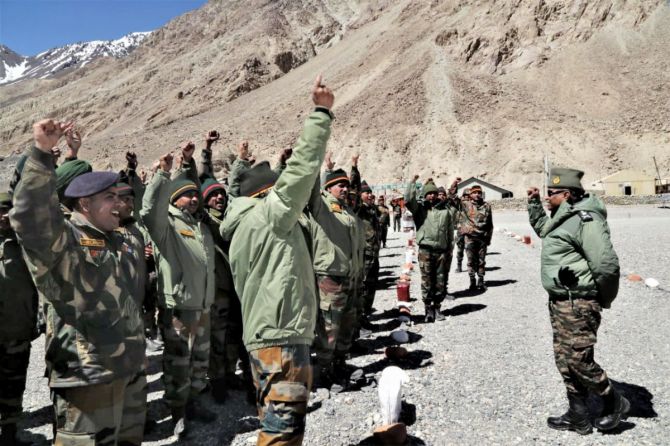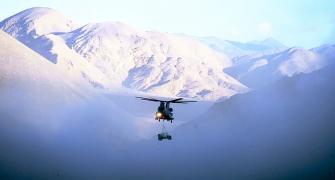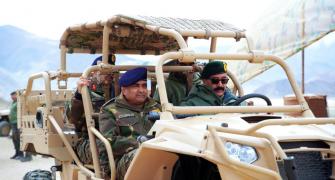In the confrontation in Doklam, where Indian and Chinese soldiers were lined up eyeball-to-eyeball, senior Indian commanders recount they could sense the uncertainty in the Chinese.
While Indian soldiers had to be restrained from pushing the Chinese troops back, our chief interpreter heard the Chinese officers threatening to open fire on PLA soldiers who wavered or withdrew, reveals Ajai Shukla.

- Part 1 of the Ajai Shukla column: Is India ready for Pak superiority in drone warfare?
Another critical Indian weakness lies in what has been dubbed 'Grey Zone warfare': Which involves information, disinformation, cyber-attacks, gathering electronic, signals and satellite intelligence and altering historical records, as it did in Tawang, Doklam and Ladakh to find a Jus ad Bellum (rationale for a war).
Chinese special forces could also snap undersea Internet cables, leaving India isolated and unable to communicate securely with its allies.
China's (and to a growing extent, Pakistan's) domination of India's military in wartime is not just in high-tech fields such as artificial intelligence. It is also evident in conventional fields, such as long-range fires to support ground operations.
In this, Indian forces that need fire to support ground operations have few choices besides Pinaka rockets and BrahMos cruise missiles.
Meanwhile, Pakistan has acquired, or developed, the Hatf series of missiles, and a cruise missile that can deliver a nuclear payload. India's ballistic missiles would constitute a form of deterrence, if only China were to leave the command and control systems functional.
The government, instead of making up for these deficiencies, dismisses the military's concerns.
At the combined commanders conference, held in 2015 on the INS Vikramaditya, Modi collectively asked the commanders present what they considered India's premier military threat. When the generals, air marshals and admirals said they considered China to be India's most likely threat, Modi would have done well to introduce the generals, admirals and air marshals to some of the tenets of informatised warfare. Instead, he sagely stated: 'You may believe that but, from my perspective, I believe that China is not a military threat at all to India.'
Less than two years later, Indian troops were in eyeball-to-eyeball confrontation with Chinese troops in Doklam, Sikkim.
Five years later, the PM found himself dealing with large-scale Chinese troop incursions in Eastern Ladakh, the deaths of 20 Indian soldiers and the loss of significant Indian territory in the Depsang sector at the northern tip of Ladakh.
Alongside these disadvantages, one significant, and oft-overlooked military advantage that India has against China is the resilience and fighting quality of our combat forces. The difficulties that soldiers face in high mountain terrain severely test even the most rugged of them.
In contrast, the average Chinese soldier is a lone male child, pampered by an adoring family and ill-prepared for the hazards and discomforts of the Line of Actual Control.
In the confrontation in Doklam, Sikkim, where Indian and Chinese soldiers were lined up eyeball-to-eyeball, senior Indian commanders recount that they could sense the uncertainty in the Chinese line.
While Indian soldiers had to be restrained -- verbally as well as physically -- from pushing the Chinese troops back, our chief interpreter heard the Chinese officers to the rear of their line threatening to open fire on any of their soldiers who wavered or withdrew from the line.
This man-to-man advantage that Indian jawans on the LAC enjoy over the relatively comfort-loving Chinese soldiers would be eroded once the ranks of hardened jawans, enrolled on long-service tenures, are diluted by significant numbers of so-called Agniveers -- soldiers enrolled on short-service tenures of four years.
Of these, only 20 per cent (25,000 soldiers from each year's batch of 125,000) will be retained for long-service tenures. There is apprehension amongst the generals that, as the percentage of Agniveers rises, the hard edge of the army will soften.
The only redeeming factor is that, in any war with China, India would not be alone. With its growing relations with Indo-Pacific democracies such as Japan, Australia, the UK and the US, New Delhi would react to the inevitable reverses by quickly aligning and combining forces with the AUKUS and Quadrilateral groupings.
China would find its forces being split in two directions -- the land border with India and the South China Sea maritime theatre.
Handling the diplomatic and strategic levers in this conundrum would be a major challenge for New Delhi.











